TABLE OF CONTENTS
In this tutorial, you will be:
- RooCODE running inside VS Code
- Have Hyperstack AI Studio configured as your custom model provider
- A fully functional AI coding assistant powered by Hyperstack AI Studio, based inferenced LLM
Let’s begin by understanding what RooCODE is and why developers are adopting it so rapidly.
What is RooCode?
RooCODE is an advanced, agentic AI development platform that helps developers design, architect, and build software projects using intelligent agents directly in VS Code.

Unlike traditional AI coding assistants that simply autocomplete or generate snippets, RooCODE takes a more holistic, multi-agent approach combining architecture design, code generation, debugging, and project management into one smooth workflow.
Key Features of RooCode
- Agent-Oriented Development: RooCode uses intelligent AI agents such as Ask, Architect, Developer, and Debugger to assist with various stages of software creation.
- Multi-Model Support: It’s compatible with OpenAI, Anthropic, and other custom API providers including Hyperstack AI Studio.
- Architecture-Aware: The Architect agent can reason about project structure, dependencies, and best practices before generating any code.
- Integrated in VS Code: Seamlessly embedded in your favorite IDE no context switching.
- Collaborative AI: Allows multiple agents to reason together and refine solutions before final implementation.
Why RooCode Matters
RooCODE represents a major leap in AI-assisted programming because it goes beyond code completion. We can literally describe what we want to build and RooCode agents design, reason, and implement the code collaboratively. It’s especially useful for:
- System Design & Prototyping: Describe a system, and RooCode architects it.
- Rapid Iteration: Modify architecture or features instantly through conversational inputs.
- Error Detection: RooCode Debug agent can spot potential issues early.
- Team Productivity: AI agents handle boilerplate and setup, letting teams focus on logic and design.
So now that we understand why RooCode is powerful, let’s explore how Hyperstack AI Studio fits into this ecosystem.
Why to Use Hyperstack AI Studio with RooCode?
Hyperstack AI Studio is a comprehensive generative AI development platform that enables developers to train, fine-tune, and deploy custom large language models (LLMs) with ease. It provides all the infrastructure you need to manage models from inference to evaluation without the overhead of managing servers or GPU clusters.
Integrating Hyperstack AI Studio with RooCODE gives you the freedom to choose your model backend while maintaining a powerful coding interface inside VS Code. Here’s why this combo is so effective:
- OpenAI-Compatible: RooCODE supports the OpenAI API and Hyperstack’s API is fully compatible.
- Fine-Tuned Models: Use your custom fine-tuned model in RooCODE to get project-specific intelligence.
- Playground Testing: Validate your fine-tuned LLMs in Hyperstack before integration.
- Cost-Effective: Optimize model size and compute cost based on your team’s needs.
- Secure: Keep your API keys, data, and model usage within your own organization.
- Monitoring: Track model performance and usage analytics through Hyperstack’s dashboard.
With this integration, Hyperstack acts as your AI engine, while RooCODE becomes the intelligent interface through which you interact with that engine.
Integrating Hyperstack AI Studio with RooCode in VS Code
Now that we understand both tools, let’s walk through how to actually connect them.
Step 1: Download and Install VS Code
First, we will need to install Visual Studio Code if we haven’t already.
- Visit their official website to download the installer.
- Click on Download for your OS.

- Once downloaded, run the installer and follow the setup instructions.
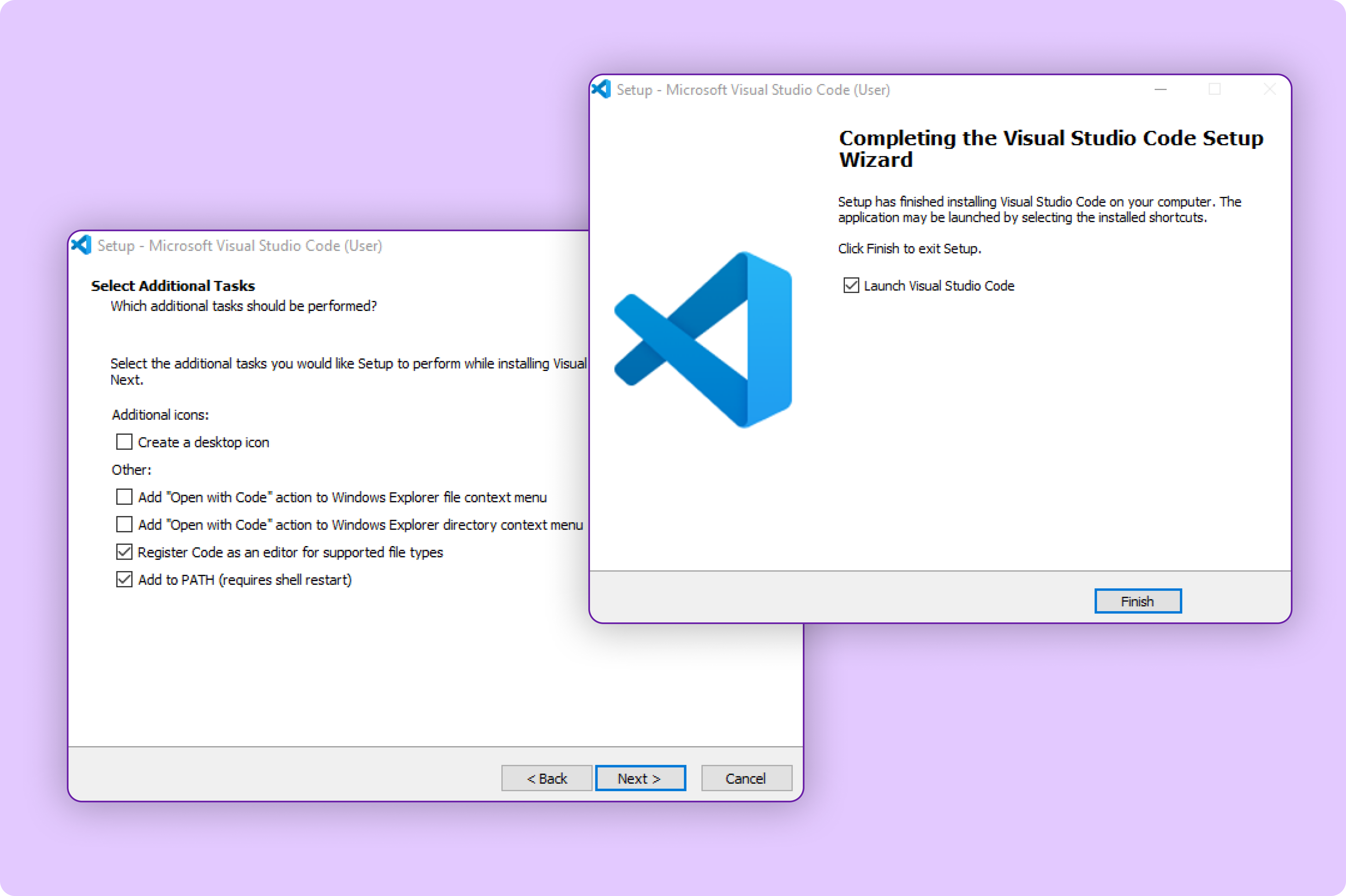
Once the installation completes, open VS Code from your desktop or applications menu.

Great, so now we have VS Code installed, we can move on to adding the RooCode extension.
Step 2: Install the RooCode Extension
Now that we have VS Code ready, let’s add the RooCode extension that will allow us to interact with AI agents directly inside our editor.
- Open VS Code.
- Click on the Extensions icon on the left sidebar or press
Ctrl + Shift + X(Windows/Linux) orCmd + Shift + X(macOS). - Search for “RooCode” in the marketplace search bar.
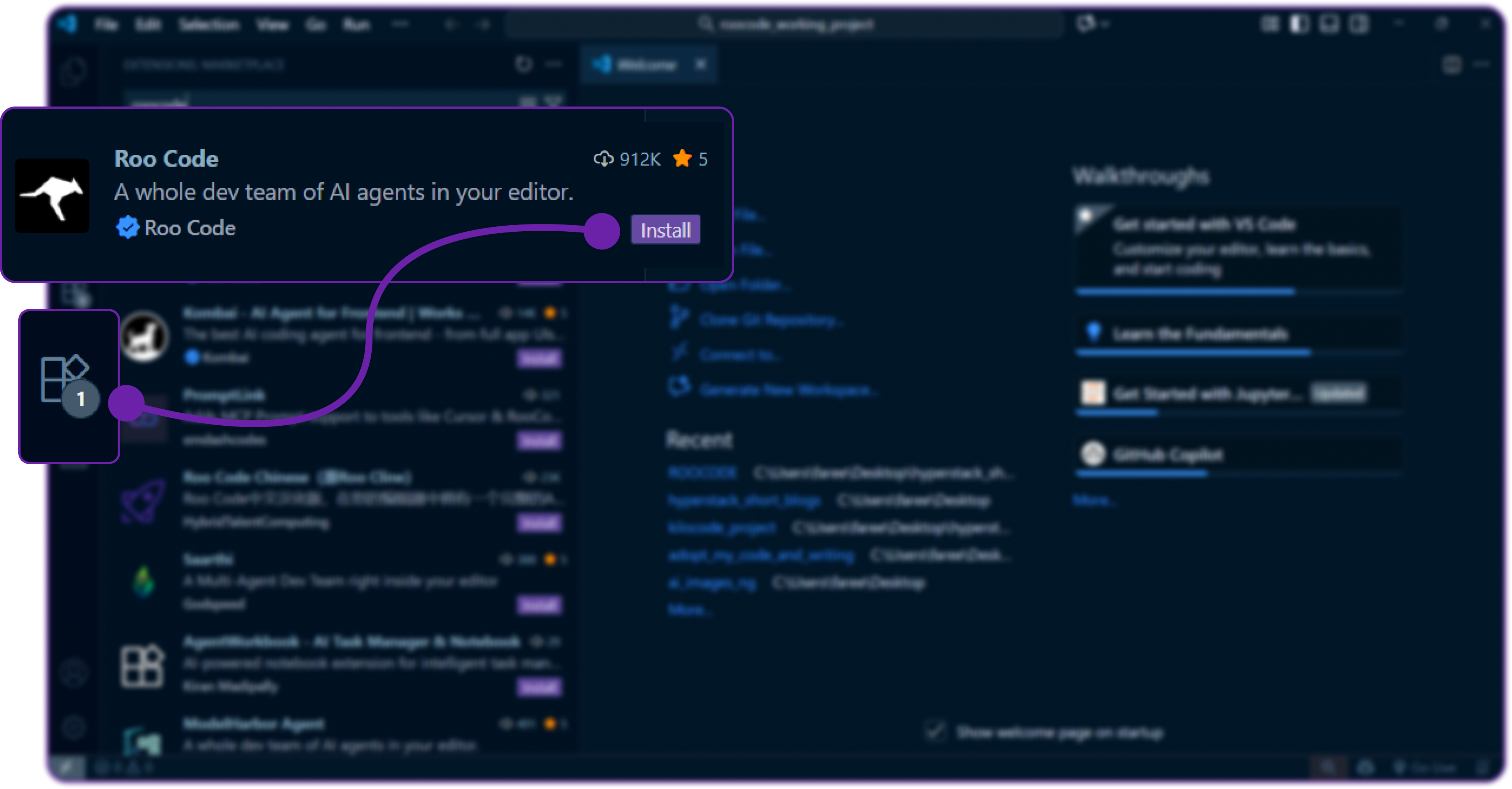
- Click Install and it will start downloading the extension and add it to your VS Code environment.

You might be ask to accept the publisher of Roo code extension, just click Accept. Since it's an AI agent, it will need permissions to read and write files in your workspace.

After installation, you’ll see Roo Code appear in your VS Code sidebar. We can now open the RooCode panel to start configuring it.
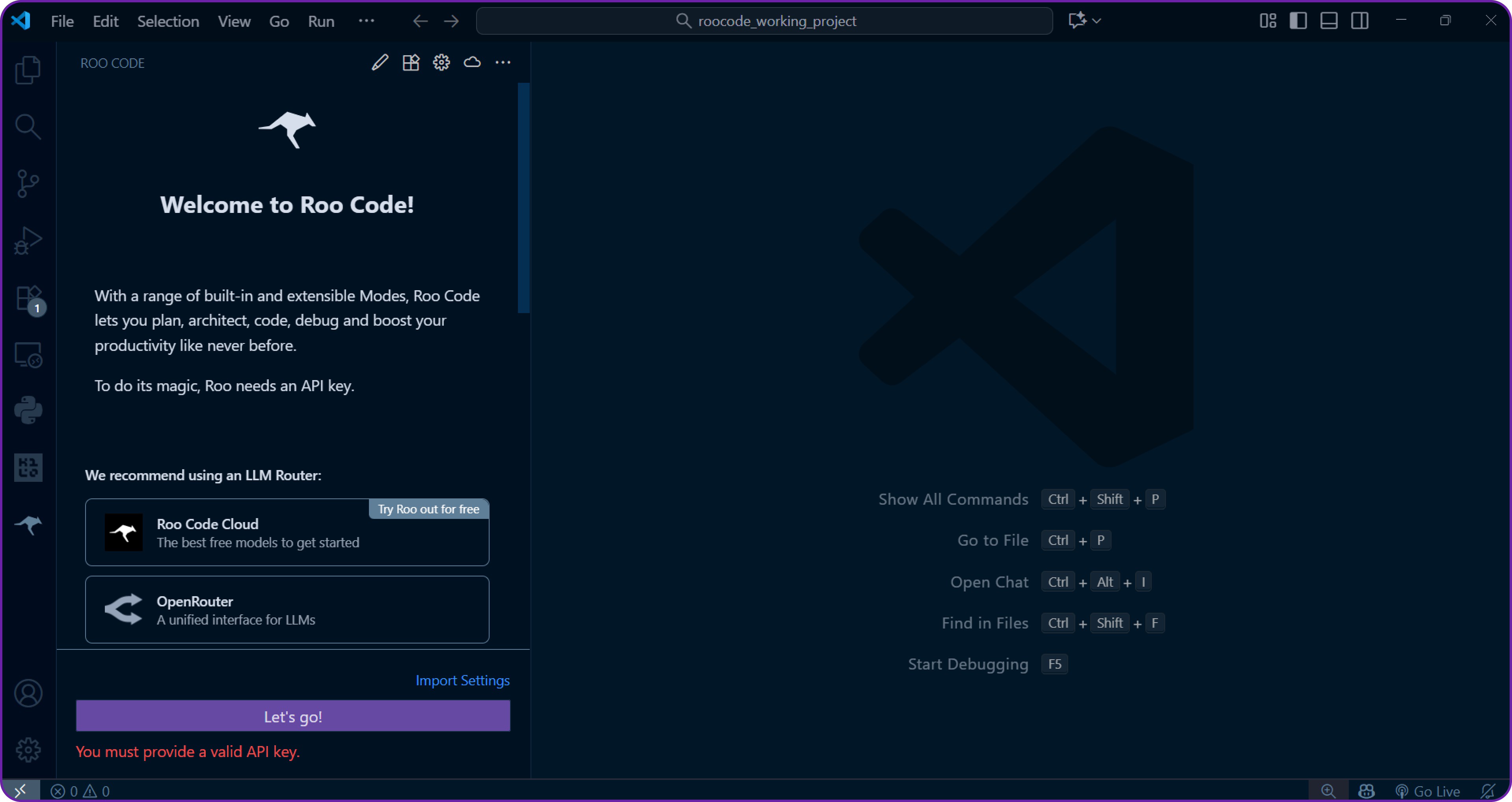
This is what the Roo Code interface looks like when we installed it's extension.
Step 3: Setting Up RooCode
We are going to connect Roo Code with LLMs hosted on Hyperstack AI Studio.
Since Hyperstack follows the OpenAI-compatible schema, RooCode can easily connect to it without any custom adapters.
Now head over to the Roo Code settings in VS Code by clicking the gear icon in the Roo Code sidebar and selecting Settings.
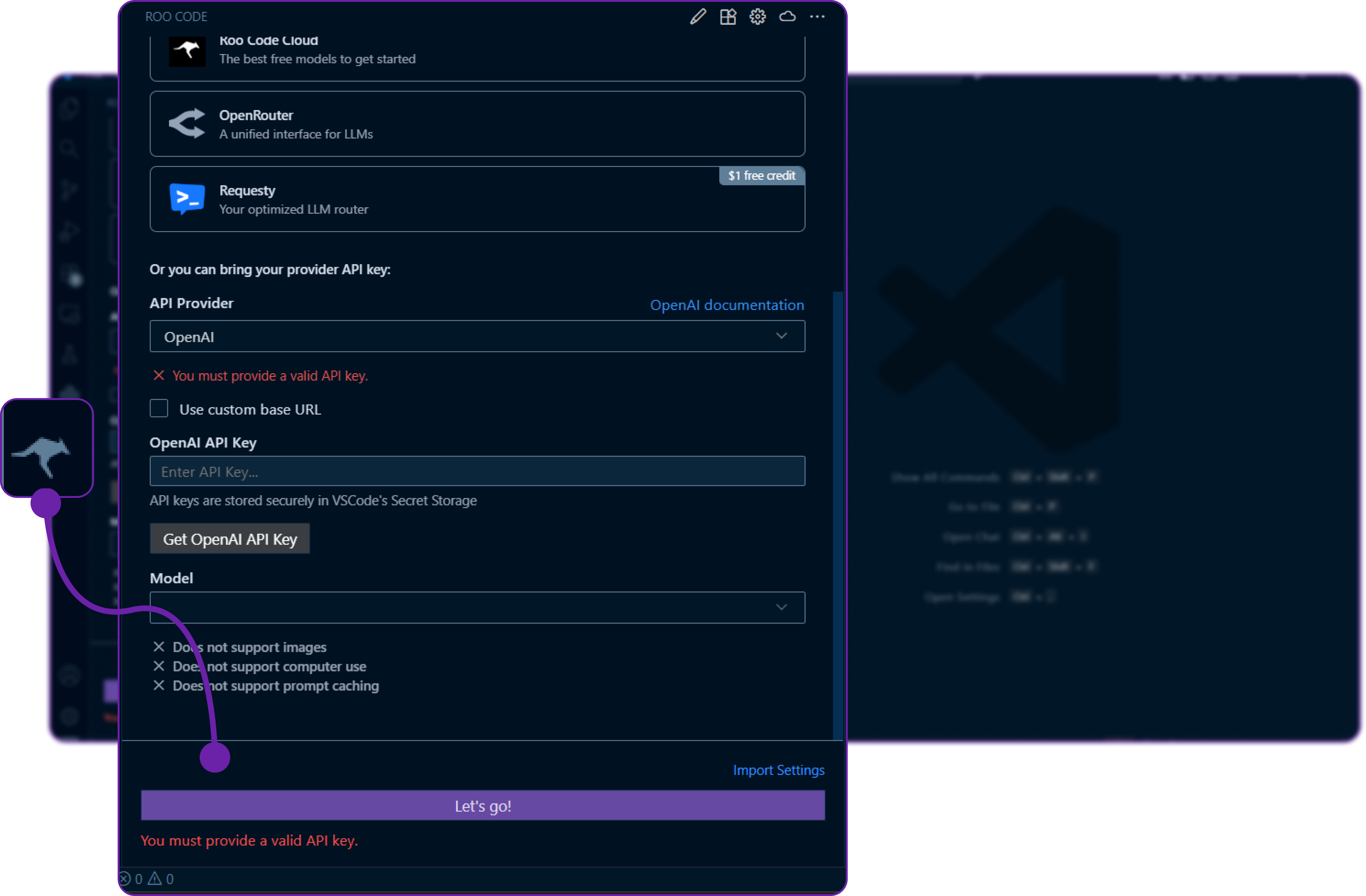
You can see that it support multiple API providers we need couple of things like BASE URL, MODEL NAME and API KEY to connect to our custom LLM provider.
Let's move on to the next step to get these details from Hyperstack.
Step 4: Retrieve Hyperstack API Details
- Go to the Hyperstack Console and log in with your credentials.
- Navigate to the AI Studio Playground to explore available models before integration them with RooCode.

In the playground, Select your desired model after quick testing it on the interface. We are going with gpt-oss-120b for this integration.
Then click on the API section to get the Base URL and Model ID.

You can check the available models on their base model documentation page. You can copy the model id and base url from here, we will need it in the next step.
Step 5: Generate an API Key
To authenticate, we will need a valid API key from Hyperstack AI Studio.
-
Go to the API Keys section in the Hyperstack console.
-
Click Generate New Key.
-
Give it a name (e.g.,
RooCode-integration-key). -
Copy the generated key, we will use it in Roo Code extension.

Now that we have the required details for Roo code, let's now use them in the Roo code extension.
Step 6: Add Hyperstack Details into RooCode
Now that we have our Base URL, Model Name, and API Key from Hyperstack, let’s plug them into RooCode.
First we have to select the correct API provider which is OpenAI Compatible since Hyperstack follows the OpenAI schema.

Then we fill in the details we copied from Hyperstack:
- Base URL →
https://api.hyperstack.cloud/v1 - Model Name →
openai/gpt-oss-120b - API Key → Paste your newly generated Hyperstack key
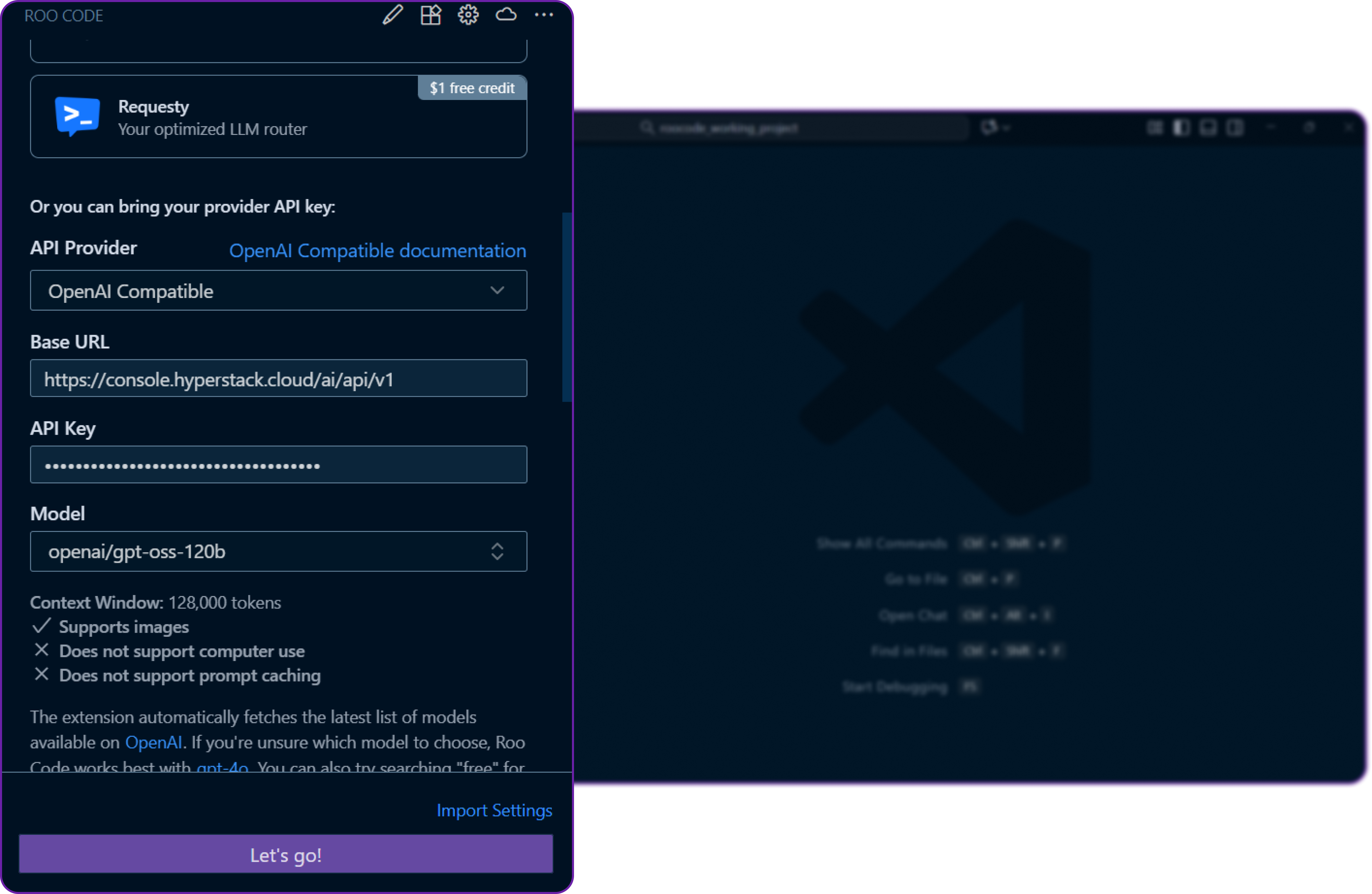
Once we save the configuration by clicking on Let's go button, Roo Code will treat Hyperstack as a valid model providers exactly like OpenAI.
We have named this configuration to Hyperstack profile, which is totally an optional step but better for organization if we have multiple profiles.
Step 7: Test the Connection
Alright, now we need to test that if our integration is working or not.
- In VS Code, open the Roo Code Ask panel.
- Make sure the selected model is
gpt-oss-120b. - Select the ask panel from drop down.

- Let’s pass a simple prompt like
"Hi"to see how our RooCode Ask feature is handling the request.
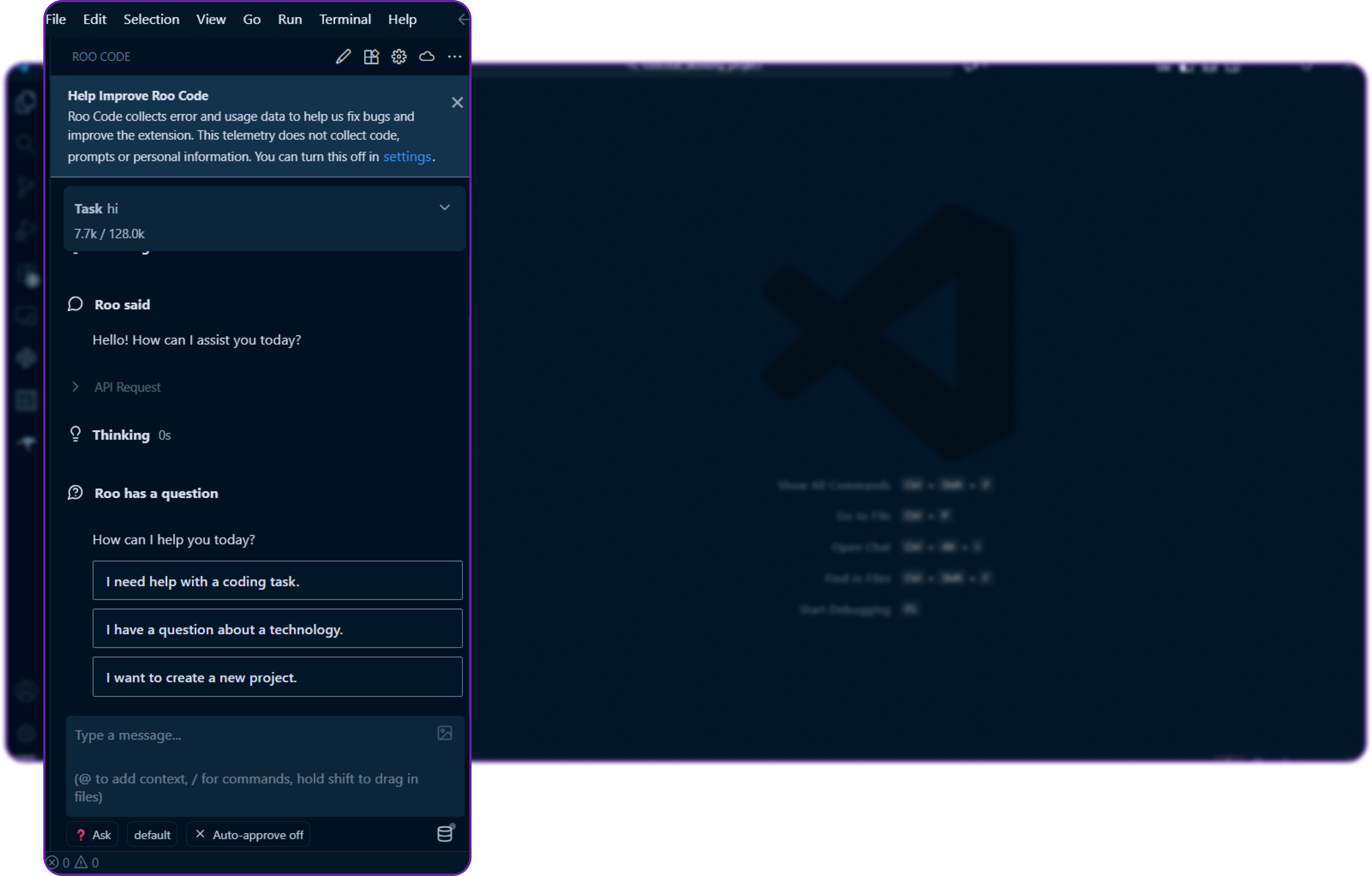
We get a response of ...
“How can I assist you today?”
then our integration is working perfectly! That means Roo Code is successfully talking to our Hyperstack-hosted model.
You can also see that since it's a code editor tool it has print out several other important things like the next expected query, checkpoint to avoid data loss, and the latency of the request.
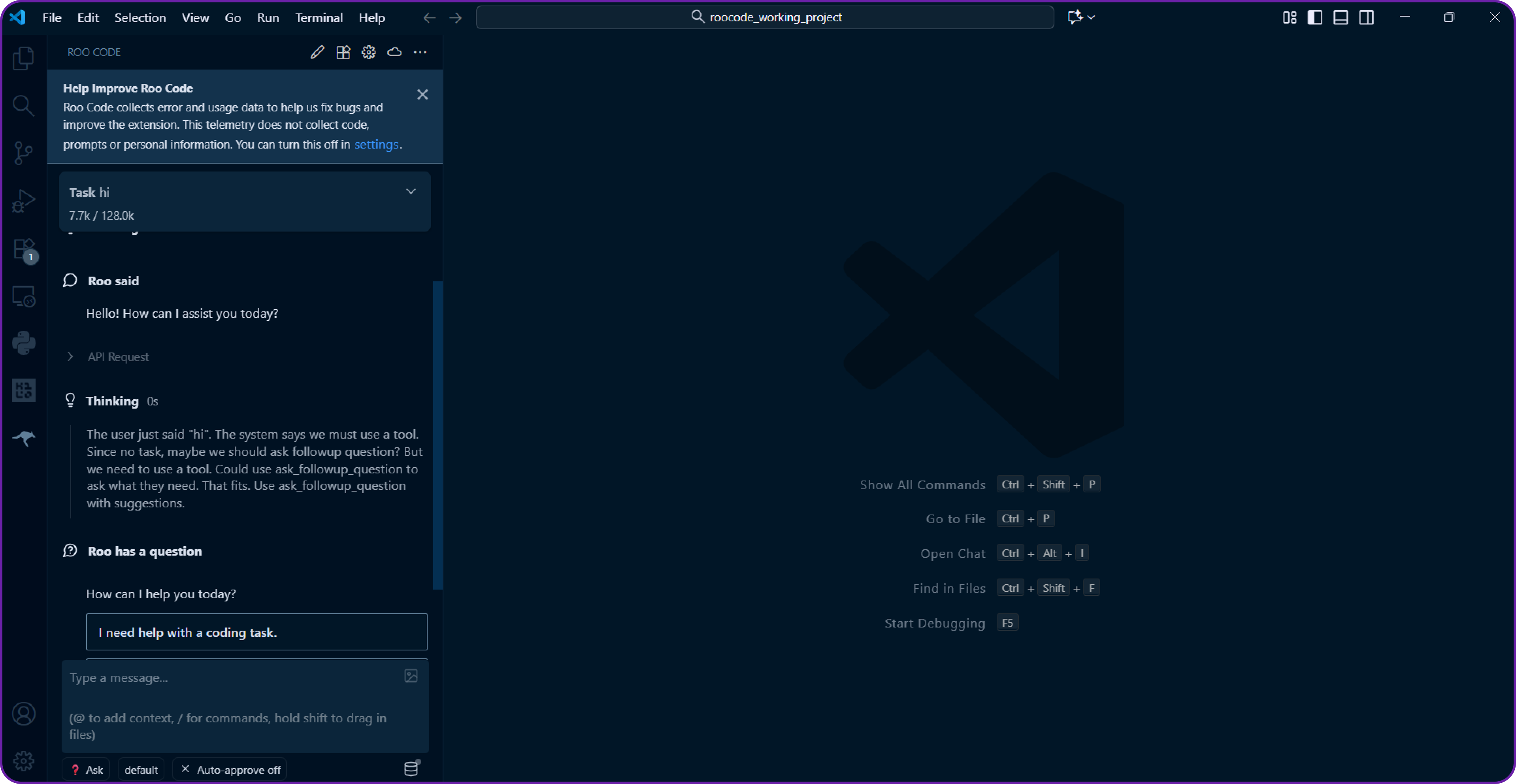
You can see the thinking of our model also before the generated response. There is a serious potential here, we can now use Roo Code’s powerful agentic workflow powered by our own custom model in Hyperstack!
Step 8: Test Architect Mode (Design and Code Generation)
Now let’s try something more advanced using the Architect agent to design and implement a code structure.
- In RooCODE, switch the task type to Architect.

- We are going to ask it to design a simple web application AI chatbot.
Design an architecture of simple AI chatbot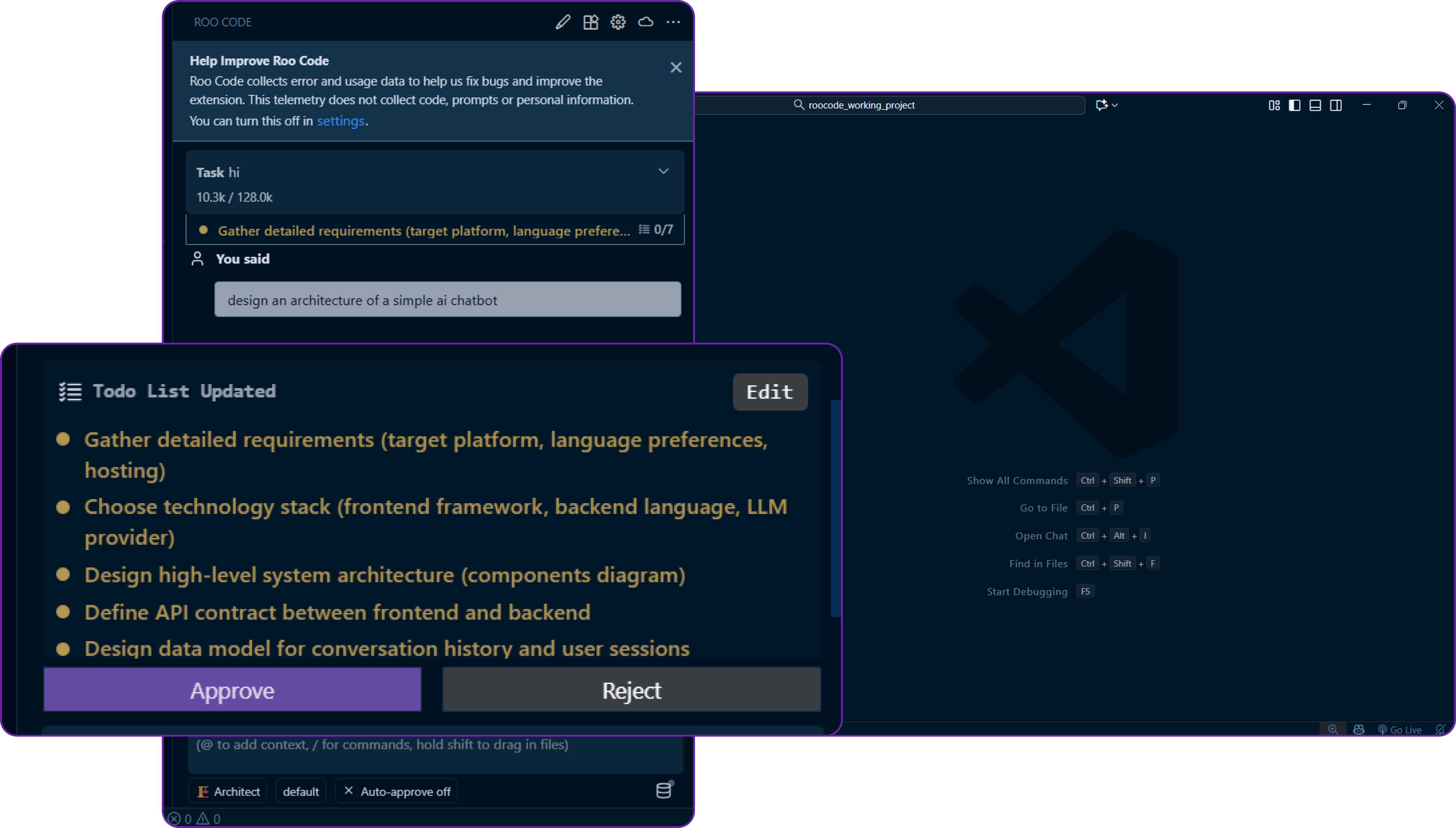
After passing this prompt it will first give us the entire to do task that the agent will perform before actually executing, once we approve this workflow.
The agent will perform multi step conversation with us, this way our agent keep improving it's goal before actually executing the entire decided workflow.
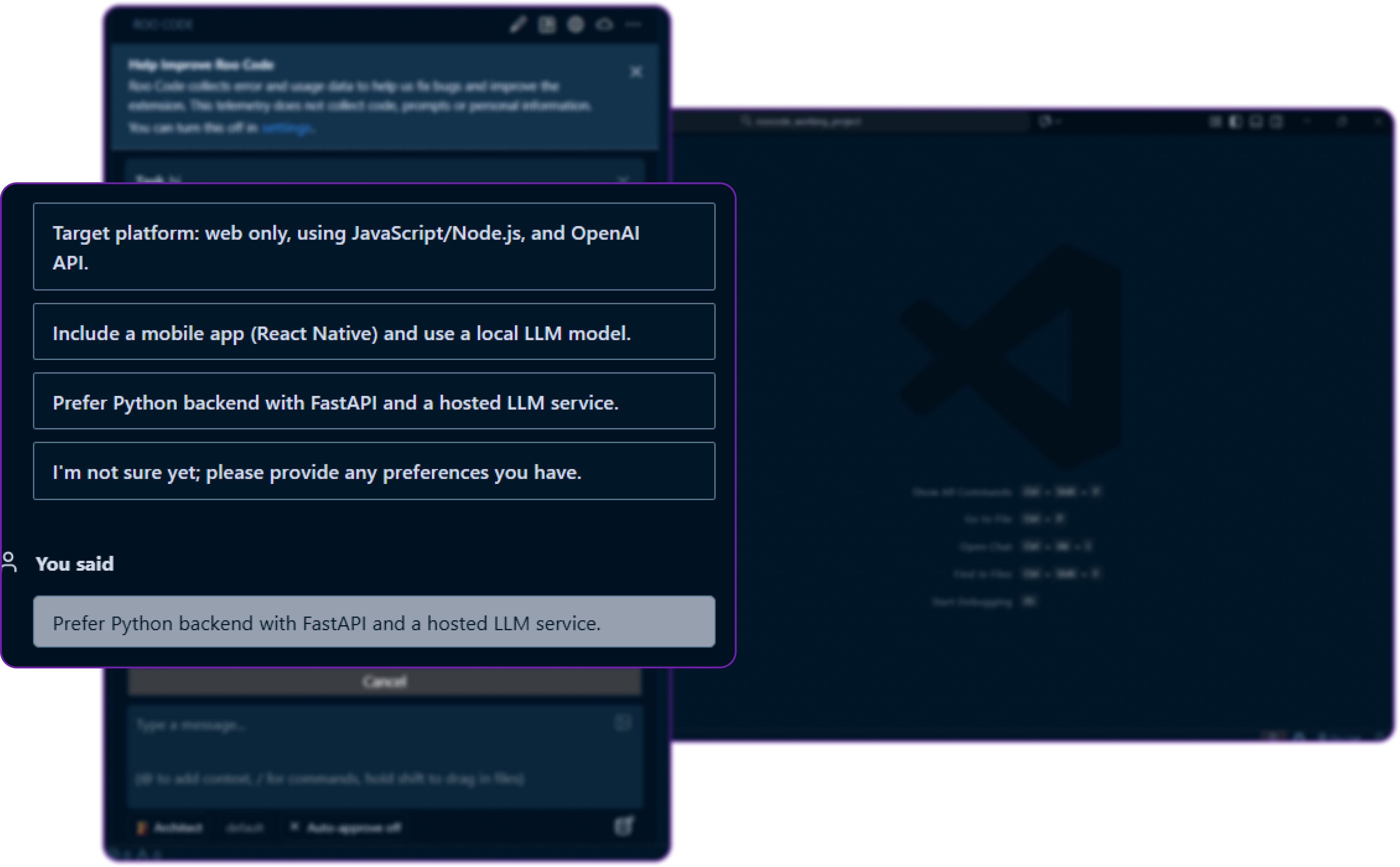
It will keep asking the user, whether the implementation of our agent after each step is acceptable or not.

That's the biggest advantage of RooCode as it keeps learning while the implementation.
Once all the steps are approved, it will start generating code files according to previous step that are defined earlier.
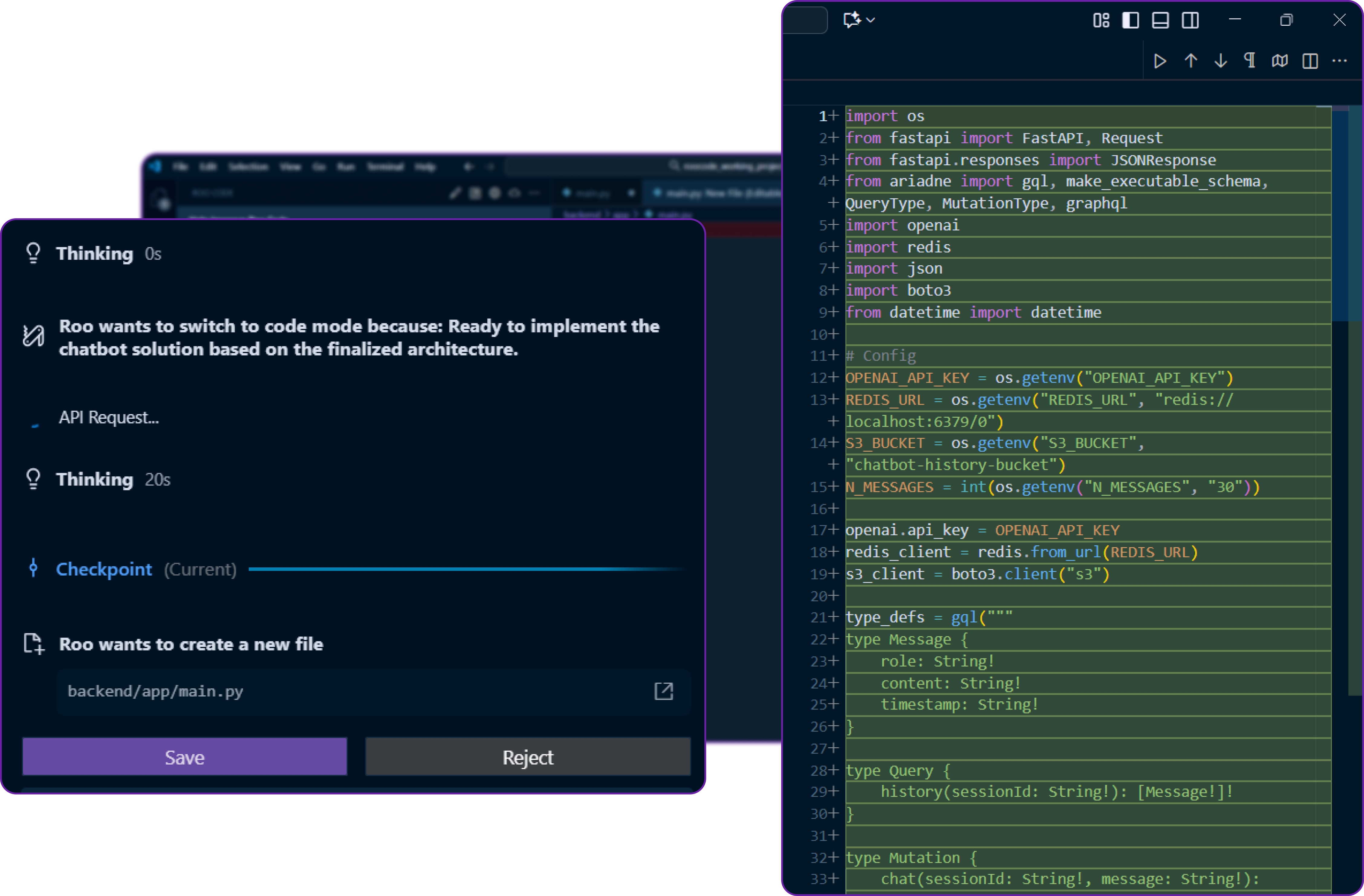
You can also monitor the change the agent is making while coding, similar to how a dev team organize and debug the code through GitHub.
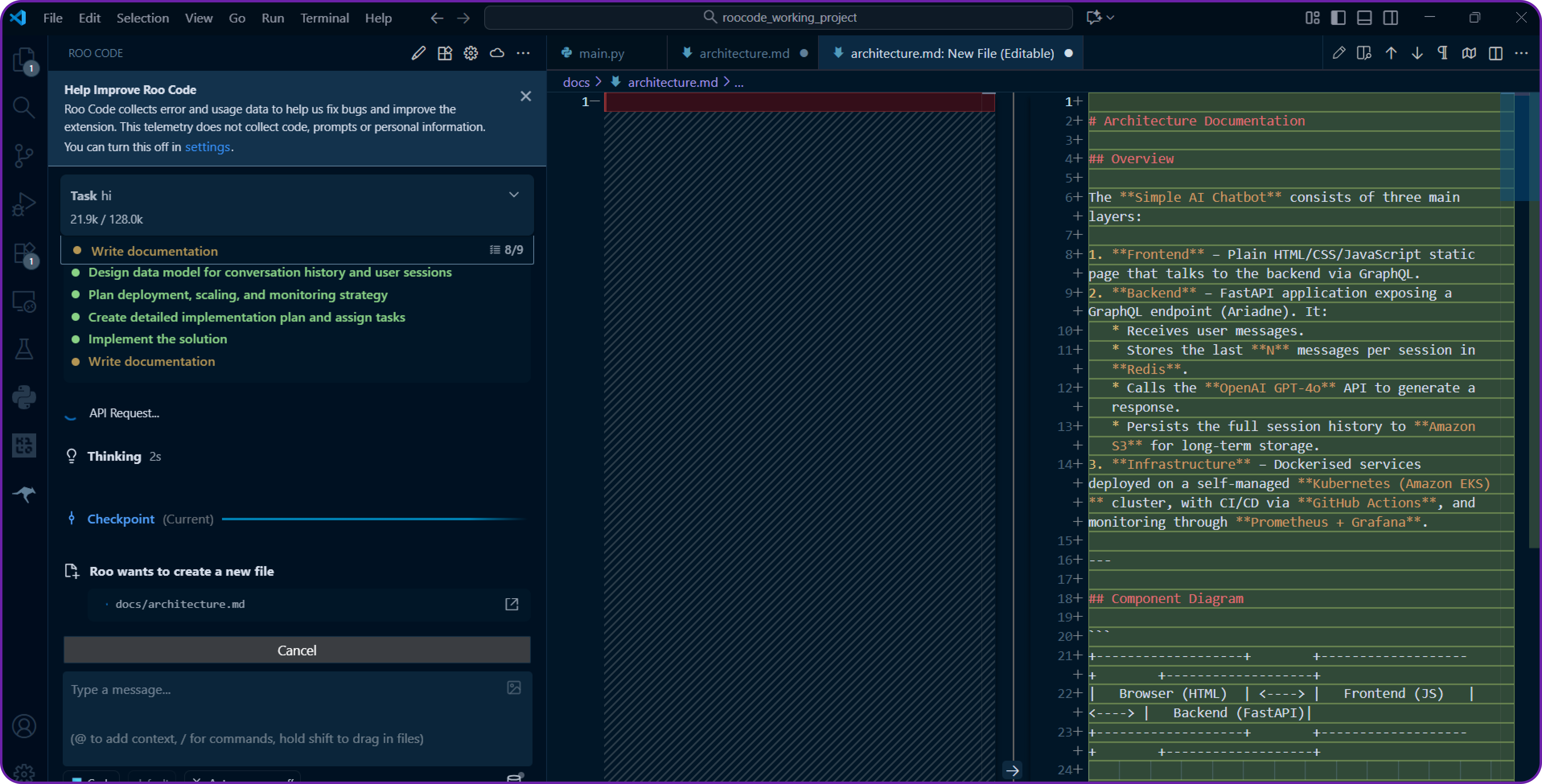
We can also use RooCode built-in Debug agent to fix issues in real-time. As the AI generates and modifies files, it logs each step making debugging straightforward.
Step 9: Monitoring the Usage
Once everything is integrated, we can monitor how our models are performing.
- Hyperstack Console: Go to the Usage Dashboard under billing to see API call metrics, token usage, and costs associated with your models.

-
RooCode Logs
Inside VS Code, RooCode also provides logs and metrics for model requests helping us track latency and response history.
It also gives us insights into the context length used, which is crucial for optimizing prompt design.
Why This Integration Is Important
By integrating RooCode with Hyperstack AI Studio, we combine two strengths:
- RooCode handles multi-agent reasoning, task orchestration, and direct code interaction.
- Hyperstack provides a scalable, customizable model backend that’s fine-tuned for your exact needs.
This means we can:
- Use our own fine-tuned models trained on private repositories
- Keep full control of our model data and performance
- Adapt model size to balance speed and cost
- Build secure, private AI coding environments
In short, Hyperstack is the brain, and RooCode is the hands.
What are the Next Steps
Now that we have connected RooCde to Hyperstack, here are a few things we can explore next:
- Fine-Tune a Custom Model: Train your company-specific LLM on internal codebases.
- Use the Evaluation Framework: Benchmark your fine-tuned model’s coding accuracy.
- Experiment in the Playground: Test prompts and model behavior before deploying.
- Team Integration: Share the same Hyperstack model configuration across your team.
- Extend RooCODE Agents: Customize agent behavior or add new tools around your Hyperstack models.
Conclusion
We’ve just walked through how to integrate Hyperstack AI Studio with RooCODE in VS Code, creating a truly intelligent coding environment.
- RooCODE brings multi-agent reasoning, architecture design, and AI coding into your IDE.
- Hyperstack AI Studio powers that experience with scalable, secure, and customizable LLMs.
Together, they form a next-generation AI development stack one that’s powerful, private, and fully under your control.
Now go ahead and start building with RooCODE and Hyperstack your new AI-powered coding team is waiting inside VS Code.
FAQ
1. Do I need to pay for both RooCode and Hyperstack AI Studio?
Not necessarily. RooCODE has a free version that supports custom API connections, while Hyperstack offers flexible pay-as-you-go pricing based on your model usage. You can start testing the integration using the free tier from RooCODE.
2. Can I connect multiple models from Hyperstack to RooCode?
Yes! RooCODE allows you to register multiple model providers. You can easily add several Hyperstack models (e.g., gpt-oss-120b, or your fine-tuned ones) and switch between them for different types of tasks or agents.
3. What if my Hyperstack API key stops working?
If your key expires or is revoked, RooCODE will simply fail to authenticate. You can generate a new key anytime from your Hyperstack Console → API Keys page and update it in RooCODE’s model provider settings.
4. Is my project data sent to Hyperstack when using RooCODE?
Only the data you explicitly send in prompts or context is transmitted. Hyperstack ensures enterprise-grade security and data isolation — none of your project files are stored or reused for training unless you upload data yourself on the AI Studio, in the data module (e.g. like this).
5. Can I use fine-tuned models made in Hyperstack directly with RooCODE?
Absolutely. Once your fine-tuned model is deployed in Hyperstack AI Studio, it becomes available through an OpenAI-compatible endpoint. Just use its model ID and endpoint URL in RooCODE’s settings, and it will appear as a selectable model.
6. How do I know which Hyperstack model best fits my needs?
You can test different models directly in the Hyperstack Playground. Try various LLM sizes and check their latency, reasoning ability, and token cost before finalizing one for RooCODE.
7. Can I monitor my AI usage inside RooCODE?
Yes — RooCODE provides logs and model activity insights. Additionally, you can view detailed usage analytics, response latency, and cost metrics on your Hyperstack dashboard.
8. Does RooCODE require internet access to use Hyperstack models?
Yes. Since Hyperstack models are hosted in the cloud, RooCODE needs an active internet connection to send API requests and receive responses from your model endpoint.
9. What kind of projects can I build with RooCODE + Hyperstack?
Almost anything from backend APIs and CLI tools to web apps or microservices. With Hyperstack’s fine-tuning and RooCODE’s agentic reasoning, you can tailor the AI to understand your codebase, style, and framework preferences.
Subscribe to Hyperstack!
Enter your email to get updates to your inbox every week
Get Started
Ready to build the next big thing in AI?

.png)